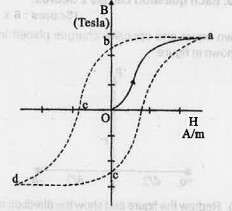What is hysterisis? Define the terms 'coercivity' and 'retentivity' of a ferromagnetic material.Solution in Kannada
Step by step video & image solution for What is hysterisis? Define the terms 'coercivity' and 'retentivity' of a ferromagnetic material. by Physics experts to help you in doubts & scoring excellent marks in Class 12 exams.
Updated on:21/07/2023Topper's Solved these Questions
Similar Questions
State Coulomb's law .
View SolutionDraw a neat labelled diagram of an ac generator or dynamo.
View SolutionRetentivity And Coercivity
View SolutionDefine the term retentivity and coercivity.
View SolutionSTATEMENT-1 : Hard ferromagnetic materials are used for data storage .
and
STATEMENT-2 : Retentivity of hard ferromagnetic materials is very small .
View SolutionWhat is hysterisis? Define the terms 'coercivity' and 'retentivity' of a ferromagnetic material.
View SolutionThe figure gives experimentally measured B vs H variation in a ferromagnetic material. The retentivity, coercivity and saturation respectively, of the material are:
View SolutionWhat is hysterisis? Define the terms 'coercivity' and 'retentivity' of a ferromagnetic material.
View SolutionWhat is hysterisis? Define the terms 'coercivity' and 'retentivity' of a ferromagnetic material.
View SolutionMaterial used for preparing electromagnet should have high retentivity and high coercivity.
View SolutionThe hysteresis curve for a material is shown in the figure. Then for the material retentivity, coercivity and saturation magnetization respectively will be

View SolutionThe hysteresis curve for a material is shown in the figure. Then for the material retentivity, coercivity and saturation magnetization respectively will be
View SolutionDefine the term retentivity and coercivity.
View SolutionDefine magnetic retentivity for a ferromagnetic substance.
View SolutionWhat would be retentivity and coercivity of permanent magnet? Why?
View SolutionThe B-H curve of a ferromagnetic material is as shown in figure :Identify the value of retentivity and coercivity from the figure.

View Solution
